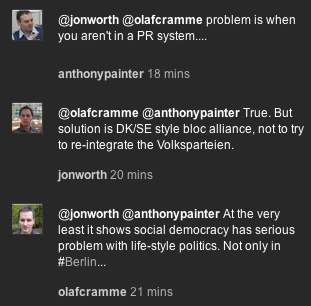Nordic bloc politics – the solution for a fractured left?

 A Twitter exchange this afternoon with @olafcramme and @anthonypainter (shown in the screenshot to the right) in light of both Thursday’s election in Denmark and today’s Berlin state election got me thinking: is Nordic bloc politics the solution to the fracturing of the left, the problem so compellingly highlighted by David Miliband?
A Twitter exchange this afternoon with @olafcramme and @anthonypainter (shown in the screenshot to the right) in light of both Thursday’s election in Denmark and today’s Berlin state election got me thinking: is Nordic bloc politics the solution to the fracturing of the left, the problem so compellingly highlighted by David Miliband?
The contrast between Denmark and Berlin is that in the former the likely coalition configuration was well known before the elections – Social Democrats would definitely work with the Socialist People’s Party (SF) and most likely with the Radicals and, if necessary the far-left Unity List. The media labelled this the Red bloc. The opponents – the Blue bloc – composed the liberals (Venstre) and the Conservatives with parliamentary support of the Danish People’s Party. So fracturing of the left did not matter enormously in Denmark – it was the bloc’s vote that mattered. This development reflects the same tendency in Swedish general elections in 2006 and 2010.
Conversely in Germany – at the 2009 Bundestagswahl (my blog on that here), and at every Landtagswahl subsequently, the problem of how the SPD deals with the Left Party (Die Linke) rumbles on. Equally the SPD also still flirts with the idea of forming a grand coalition with the CDU, while support for The Greens continues to grow. Meanwhile in Berlin, the entry into the state parliament of the Pirate Party with 8.8% of the vote complicates matters still further.
Learning the lessons from Denmark and Sweden, would it not be best for the SPD to ally themselves strongly with The Greens, the Left Party and even The Pirates and present themselves as a Red bloc before 2013’s Bundestagswahl?
And who could the red-green alliance (enhedslisten) support as PM than a red/social democratic prison. So therefore electors would have seen them as a vote for red but ensuring a pull towards the left and more socialist policies.
So I’d say the voter would have known who’d be pm and the bloc leader would know they could count on their support.